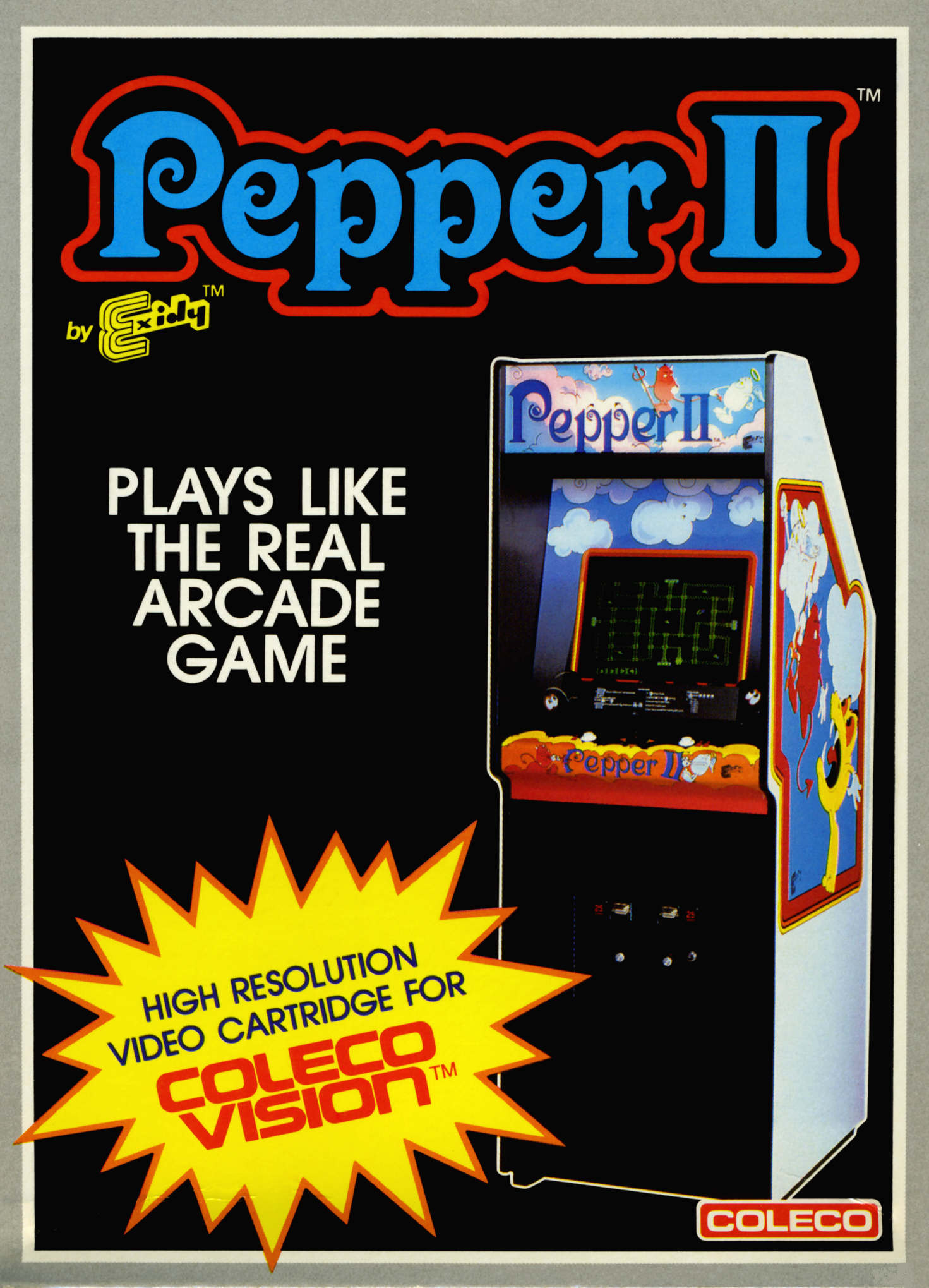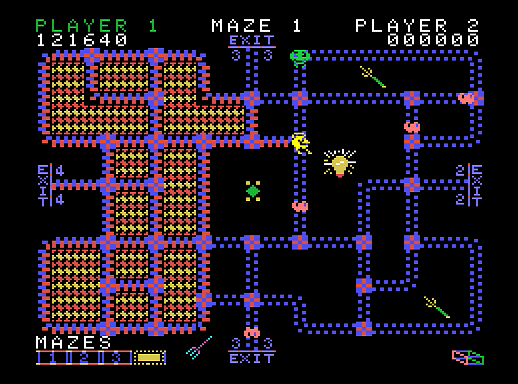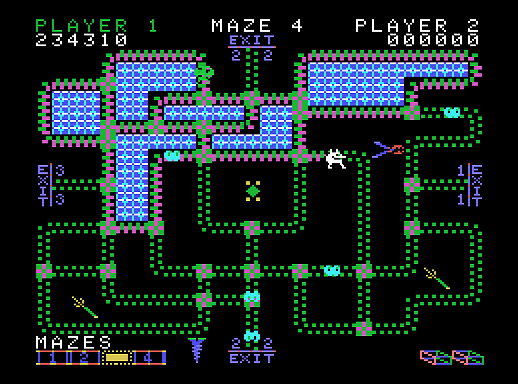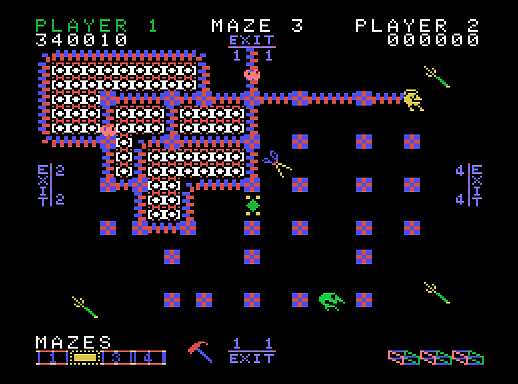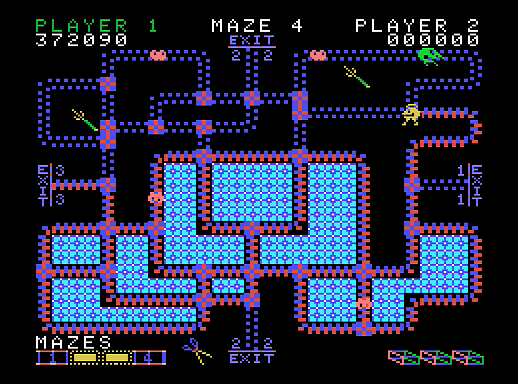PEPPER II
Another ColecoVision adaptation that beats the arcade original
Despite the title, Exidy's Pepper II coin-op, released in May of 1982, isn't a sequel. The main character harbors two personas derived from mythology: angelic and demonic. The title is therefore akin to Split-Personality Pepper. Instead of getting him some kind of help, however, we're exploiting his instability, and basically having fun with him. This appeals to me. A shrink would only fill him with harmful drugs anyway.
Pepper II was designed by Howell Ivy, whose earlier Exidy games included Death Race and Circus. He'd go on to dream up Venture and others. Larry W. Hutcherson assisted with the design and handled most of the programming. His code had built Mouse Trap and would give life to Crossbow and Fax.
The game was assigned the sensible if dull working title Zipper. Exidy founder / owner Pete Kauffman insisted on changing it, allegedly after a pepper shaker caught his eye during a meal. He didn't want to get sued by the makers of the Zipper lawn mower, whoever they were. (The manufacturer is unknown; today's Zipper Mowers wasn't established until '92.)
Pepper II steals from Namco and Midway's Pac-Man (from '80), Konami and Stern's Amidar and, to a lesser degree, Taito America's Qix (both from '81). The last provides the most freedom, as it lets the player create his own maze instead of imposing one on him. Like many other games I've covered, the particular way in which the elements, recycled or not, are combined make Pepper II unique. Its exclusive twists don't hurt, of course. Most significantly, it's damned fun, especially in its ColecoVision incarnation.
As Pepper, you're apparently hoping to assemble a giant, patchwork quilt. Maybe your mental problems have led to a life on the streets. The quilt must be rather uncomfortable, though, as the patches in each of its four screen-sized sections are joined via zippers. When you've pulled the whole thing together, a bunch of bonus points are thrown into your hat, and you get started on another quilt. Perhaps you're piling them up with the intention of selling them on the corner, or even opening a shop. Well, good for you! Such initiative can really turn your lives around.
I've pluralized that because you've got a great advantage from the get-go: You can be killed multiple times without actually ceasing to exist. This is fortunate, as you've been given the evil eye -- five pairs of them, in fact. They're sensitive to brash colors, so they're not keen on your quilt. Don't let their taunts about your dual personality weaken your resolve. Being eyes, they can't yell very loudly anyway. Just come back with, "It takes two to know two!" and buckle down on those zippers.
The eyes come into sight one by one through the periphery's four midpoints (they choose randomly) and travel along the zippers, fastened and unfastened alike. In addition to the game's RAM and ROM, then, you've got REM to contend with. One collision and it's curtains for the quilt-maker. Fortunately, entirely zipped patches stay zipped when this happens, as they do when you leave an unfinished screen. The border openings are helpfully numbered, since they serve as your own passageways between the four mazes.
I prefer the '83 ColecoVersion to the arcade game, mainly because all characters in the latter start off at fun-killingly high speeds. Challenge is one thing; navigating a maze that calls for frequent, precise turns simply isn't enjoyable when my on-screen counterpart sprints, as strategic decisions must be superseded by concentration on the very controls. I try to change directions a bit too late whenever I've glanced away to assess the positions of my enemies.
Just one missed turn in this game, at this speed, is indefensibly difficult to recover from. I'm not crazy about games that entail nothing more than continuous knee-jerk reactions. On the ColecoVision, only the two highest Skill Levels -- 3 and 4 -- involve such slippery-feet speeds. The others let me plan my immediate route and time my steering to narrowly slip by adversaries approaching at right angles.
Like CV Frenzy, the last better-than-the-coin-op translation I've written about, this is the only official home version. Its programmer(s) might have been Lawrence J. Schick and / or George Gomez. Its developer was definitely 4D Interactive Systems, a St. Paul, Minnesota company founded in early '78 by Dave Arneson, who'd created the paper role-playing game Dungeons and Dragons with Gary Gygax in '74.
As in the arcade game, the four zipper-defined mazes are all different and refreshingly asymmetrical. At any Skill Level above 1, the anti-quilt eyes -- maybe they just hate zippers, which is understandable -- are eventually joined by a faster, equally deadly creature who's always present in the coin-op, and who Exidy calls the Whippersnapper. Coleco calls him the Zipper Ripper. I call him the Discarded Experimental Muppet. Now you have a DEM to deal with, too!
As you might imagine, he prefers buttons, so he unzips any closure he reaches, provided that its patch has yet to be attached on all sides. My nickname for him is, of course, the Zippercrapper.
Pitchforks have been stitched into four patches near the corners of each screen. (This is a very sturdy quilt we're talking about.) You can temporarily change from an angelic Pepper to a demonic one, replacing your halo with horns, by zipping completely around one of these farm implements. Any wholly fastened patch will be garnished with a garish pattern to help you keep track, so the hemmed-in pitchfork will be rubbed out; but you'll pull a Pac-Man and turn the evil eyes blue.
Roughly a second after the ensuing tune, their infections will return and they'll be pink again. Until then, you'll be able to kill them for increasing points, which will reset when you enclose another pitchfork. (In the arcade version, the eyes' collective color depends on which of the four mazes you're in.)
Other cool effects of pitchfork power, which is so potent that it even alters the quilt's colors while it lasts, are the freezing of the Zippercrapper and the removal of his lethal touch. Yet another is that the eyes remain blue even when you've changed mazes. They don't follow you right away, but if you've crossed the border sufficiently soon after surrounding the pitchfork, you can continue to skewer them for a second or two.
Whenever you switch screens without your horns, be prepared to hasten from the entrance, in case you've got eyes on your heels. Those who haven't entered are still hanging out in the maze you've just left, so it's a good idea to postpone any backtracking.
The central patch in each of the four fabric labyrinths magically alternates its stuffing between a pitchfork and a shiny, diamond-shaped halo (as seen from above), so you've actually got five opportunities to turn the tables.
Surrounding the halo triggers your alter ego and, unlike the pitchfork, kills the Zippercrapper, regardless of his distance from you. Once the demon song has ended, it takes him a second to realize that he's dead and disappear. As with poked-out eyes, his replacement will soon arrive, but it's great to rid yourself of his meddling for a bit.
Besides, you can do your own damage. If you revisit the side of an unfinished patch, you'll unzip it, you nutcase. The quilt is folded a couple of times, perhaps to keep passersby from stepping all over it while you're working on it. You can think of it as cubical, as long as you can picture a cube designed by Escher. What I'm getting at is that the four exits from each maze are always open, so you can travel around the quilt in unbroken loops.
Your score rises considerably whenever you complete a maze, and you're not barred from returning to the finished screen, useless though it is (except as a conduit), until you're done with all four and you're treated to some serious pointage. Then you're off to fresh fabrics and faster foes.
Make the most of the major difference from Pac-Man in the helpless-to-powerful department: By contrast with that game's all-too-infrequent occasions for revenge, just enough pitchforks are found in each Pepper II maze to keep you almost constantly evil. Plan your route to surround as many patches as possible between them, so you won't ultimately face scattered open zippers with nary a sharp object in sight.
Whenever you can, complete two patches at once by zipping a shared edge. It's helpful to remember that you won't unzip the sides of finished patches as you arrange this. Resist overconfidence when it comes to narrowly darting past eyes; along with the Zippercrapper, they often reverse direction, even if this is more often random than predatory.
Residing elsewhere in each maze is a mere bonus-scoring item that's always worth more than the last. While this safety pin, pair of scissors, etc. obviously helps with your arts-and-crafts endeavors, try not to treat it like a special case; just enclose it along the way. Deviating to swipe the bonus points can lead to a bonus death. So can shelving your plans to pursue wandering eyes.
You might lament the additional points if you're more concerned with scoring high than having fun in the moment, but remember one of my maxims about doing well at applicable games: The longer you survive, the higher your final score will be. It's especially true in this game, in which significantly more points are awarded for wrapping up screens than anything else.
If you do find yourself in a maze that's pitchfork-free but far from finished, bear in mind that you're not required to fill a screen in one go. Complete as many patches as you can before the Zippercrapper shows up, then make tracks (as it were) before he undoes any of your handiwork. Tackle one of the other mazes for a while; at the least, delay your return until that pesky Jim Henson reject has followed you.
Starting with the second quilt, all unzipped paths repeatedly darken and return to view, giving the impression that you're undertaking this project beneath a malfunctioning street lamp. Naturally, this confounds navigation and calls for good short-term memory.
Also introduced on the second macro-level is the eyes' collective demise whenever you've enclosed a halo. As always, new ones will enter piecemeal at a regular tempo, blue and vulnerable while the hilariously cheerful demon tune (which grows tedious before long, like the music in any game) plays. Thankfully, the duration of their defenselessness is never reduced.
The current maze number is displayed at top-center. The gauge in the lower left corner lets you quickly note which mazes remain incomplete. The longer you linger in each, the faster your enemies move. Their speed advances not steadily, but in stages. They'll return to normal when you change mazes, but if you come back before they've all left, they'll still be in a hurry.
You begin the arcade game with three Peppers (unless some stingy bastard has changed it to two), and you're awarded one extra -- how generous -- at 40,000 points (unless the same bastard has set it higher). The conversion gives you five "lives" if you've chosen Skill Level 1 and three if you haven't, just like ColecoVision Frenzy, and awards an extra for every completed quilt.
It's funny that one of the bonus items is a pair of eyeglasses. Pepper's the last one around here who needs such a thing. He should be able to give it to the eyes. "Oh, it's Pepper! We didn't mean to chase you! We thought you were Pac-Man. We were monsters once, you know."
A pet peeve pertaining to game controls concerns disregarded diagonals. Even in a four-directional game, the player should be able to transition through a forty-five-degree angle without seeing his character freeze or simply ignore the new heading. Happily, both versions of Pepper II permit fluid changes in direction, so the joystick doesn't have to be hurriedly centered to split-up perpendicular movements. Pepper can be impelled to make a turn before he actually reaches it.
As with Frenzy, a more wieldy controller than the ColecoVision's pack-in can be used, since two buttons aren't necessary. Neither is one, in fact. Each of Pepper's abilities is built into -- or generated by -- his movement. The potential button functions that come to mind would make the game uninvitingly easy. Besides, eyes can't be made to sneeze, in spite of your character's name.
Of course, before you can play, you'll have to endure that purposeless CV title screen, which disallows all game-starting input and loiters for about...well, I'm not great at precisely reckoning long amounts of time, but I'd put it at about forty-seven hours. I'll bet the game is just stalling, because it knows that I'm gonna kick its ass. That must be it! Am I right? (I'm talking to myself. You needn't pay attention.)
ColecoVision Pepper II fulfills the potential suggested by the arcade game. Not only can it be started at a reasonable speed, making Pepper easier to control and liberating the strategic possibilities lurking in the circuitous zippers, but it exhibits a more finely tuned balance between Pepper's pace, those of his rivals, the varied zipper lengths and the fixed demon-time length.
Quarter-sucking corporate gluttony doesn't apply in a home game, so spare Peppers arrive more frequently, providing level-clearing goals that transcend the typical clean-sweep. In terms of being all that it can, the game needs nothing extra, apart from salt.
